The Vacuum Insulation Panels Market is estimated to be valued at USD 9.0 billion in 2025 and is projected to reach USD 13.7 billion by 2035, registering a compound annual growth rate (CAGR) of 4.3% over the forecast period.
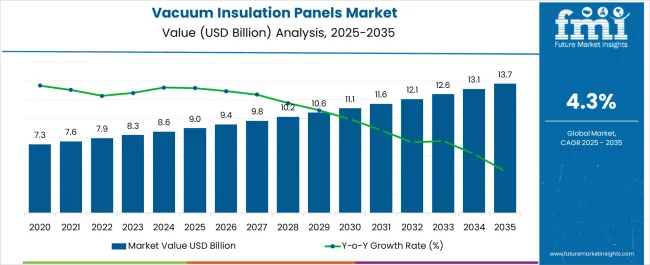
| Metric | Value |
|---|---|
| Vacuum Insulation Panels Market Estimated Value in (2025 E) | USD 9.0 billion |
| Vacuum Insulation Panels Market Forecast Value in (2035 F) | USD 13.7 billion |
| Forecast CAGR (2025 to 2035) | 4.3% |
The Vacuum Insulation Panels market is experiencing robust growth as industries increasingly adopt advanced insulation solutions to improve energy efficiency and reduce carbon emissions. These panels are gaining traction across construction, refrigeration, logistics, and consumer appliance sectors due to their superior thermal conductivity performance compared to conventional insulation materials. Rising global demand for energy conservation and compliance with stricter building energy codes are further accelerating adoption.
Manufacturers are focusing on the development of cost-effective panels with longer lifespans, improved recyclability, and enhanced durability to address sustainability concerns. Additionally, the growth of cold chain logistics and e-commerce-driven frozen food distribution is fueling the requirement for highly efficient thermal insulation solutions. Technological innovations such as thinner panels with higher insulation capacity and flexible designs are expanding their application in compact devices and space-constrained environments.
Government incentives and policies supporting energy-efficient infrastructure are also contributing to market growth As industries prioritize sustainable and high-performance insulation materials, the Vacuum Insulation Panels market is expected to continue its upward trajectory over the forecast period.
The vacuum insulation panels market is segmented by material type, design type, raw material type, application, and geographic regions. By material type, vacuum insulation panels market is divided into Silica Vacuum Insulation Panels, Fiberglass Vacuum Insulation Panels, and Other Vacuum Insulation Panels Materials. In terms of design type, vacuum insulation panels market is classified into Flat Vacuum Insulation Panels and Special Shaped Vacuum Insulation Panels. Based on raw material type, vacuum insulation panels market is segmented into Silica Based Vacuum Insulation Panels, Fiber Glass Based Vacuum Insulation Panels, Metal Based Vacuum Insulation Panels, Plastic Based Vacuum Insulation Panels, and Other Raw Material Based Vacuum Insulation Panels. By application, vacuum insulation panels market is segmented into Building Construction, Refrigeration & Cooling Appliances, Transport, and Others. Regionally, the vacuum insulation panels industry is classified into North America, Latin America, Western Europe, Eastern Europe, Balkan & Baltic Countries, Russia & Belarus, Central Asia, East Asia, South Asia & Pacific, and the Middle East & Africa.
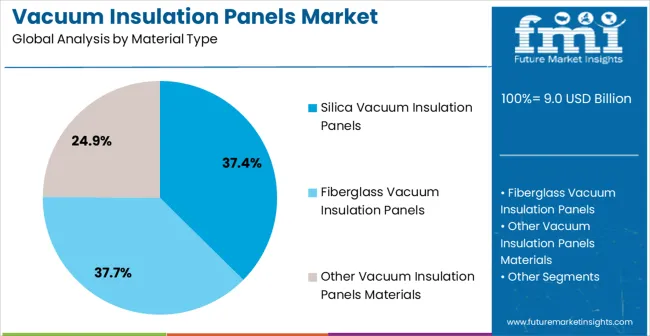
The silica vacuum insulation panels segment is projected to account for 37.4% of the market revenue in 2025, making it the leading material type. This growth is being supported by the superior thermal insulation properties of silica-based cores, which deliver consistent performance in diverse applications. The widespread availability of raw materials and the cost-effectiveness of silica panels compared to other advanced insulation materials have further driven adoption.
Industries such as construction, refrigeration, and consumer appliances prefer silica panels due to their stability, ease of integration, and durability in high-performance insulation environments. Additionally, ongoing research aimed at improving the moisture resistance and structural strength of silica-based panels is reinforcing their position in the market.
With increasing emphasis on energy conservation and compliance with green building standards, silica vacuum insulation panels are expected to remain the preferred choice for large-scale projects The balance of cost efficiency, performance, and widespread applicability ensures continued dominance of this segment throughout the forecast period.
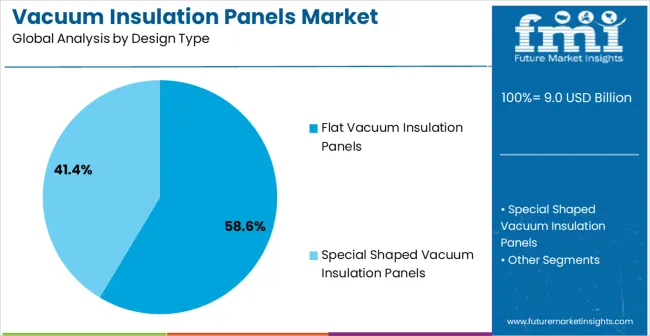
The flat vacuum insulation panels segment is expected to hold 58.6% of the market revenue in 2025, positioning it as the leading design type. Its dominance is being driven by the extensive use of flat panels in construction, refrigeration systems, and cold chain logistics where uniform surfaces and predictable performance are essential. The manufacturing simplicity and cost advantages associated with flat panel production make them more commercially viable compared to customized shapes.
Additionally, flat panels are preferred due to their easy installation, adaptability to standard structural dimensions, and high thermal efficiency, which supports energy-saving initiatives in residential and commercial projects. Advancements in production technologies are enhancing the mechanical strength and reliability of flat vacuum panels, ensuring longer operational lifespans.
As industries and governments increasingly invest in sustainable infrastructure and efficient cold storage solutions, the demand for flat panels is anticipated to expand further This strong alignment with large-scale and standardized applications continues to support the leadership of flat vacuum insulation panels in the market.
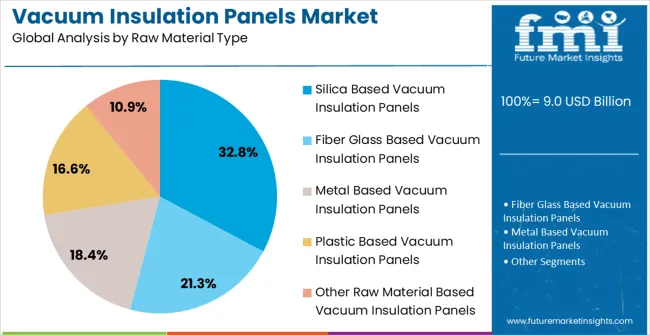
The silica based vacuum insulation panels segment is anticipated to capture 32.8% of the market revenue in 2025, making it the leading raw material type. Growth in this segment is attributed to the superior insulating properties of silica, which provide effective thermal resistance and support energy efficiency initiatives across industries. The abundance and affordability of silica compared to alternative raw materials make it a practical choice for large-scale manufacturing.
Industries such as construction and refrigeration have been increasingly adopting silica-based vacuum insulation panels due to their proven durability, lightweight nature, and compatibility with existing systems. Furthermore, advancements in silica processing technologies are improving the resistance of panels to moisture infiltration and structural degradation, enhancing their reliability.
With increasing regulatory focus on reducing carbon footprints and promoting green building practices, silica-based vacuum insulation panels are expected to remain in high demand The segment’s leadership is further reinforced by its balance of cost efficiency, performance, and scalability in meeting diverse insulation needs.
Vacuum insulated panels (VIP) are a type of thermal insulation equipment which comprise a gas tight enclosure which surrounds a rigid core from which air is evacuated to create near vacuum. These vacuum insulated panels find applications in building constructions as they deliver superior thermal insulation performance as opposed to conventional thermal insulation materials.
Vacuum insulated panels have been finding increasing applications in construction and refrigeration. Besides, stringent regulations imposed by various government agencies & regulatory bodies with regards to energy conservation and carbon emissions are anticipated to drive the growth of this market during the forecast period.
Vacuum insulated panels do not only contribute to energy conservation but also help in reducing carbon dioxide emissions. International agencies, such as the International Energy Agency, have been promoting & recommending the use of vacuum insulated panels to reduce carbon emissions. Hence, the vacuum insulated panels market, driven by these factors, is expected to grow at a significant pace during the next few years.
Considering these important aspects of vacuum insulation panels, the study of the vacuum insulation panels market becomes an important read.
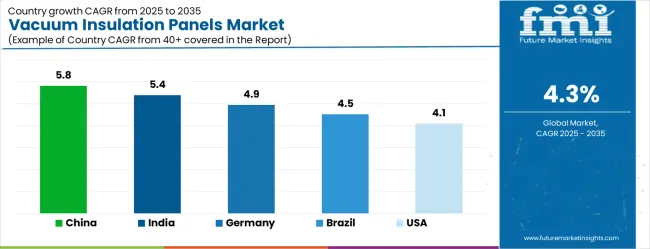
| Country | CAGR |
|---|---|
| China | 5.8% |
| India | 5.4% |
| Germany | 4.9% |
| Brazil | 4.5% |
| USA | 4.1% |
| UK | 3.7% |
| Japan | 3.2% |
The Vacuum Insulation Panels Market is expected to register a CAGR of 4.3% during the forecast period, exhibiting varied country level momentum. China leads with the highest CAGR of 5.8%, followed by India at 5.4%. Developed markets such as Germany, France, and the UK continue to expand steadily, while the USA is likely to grow at consistent rates. Japan posts the lowest CAGR at 3.2%, yet still underscores a broadly positive trajectory for the global Vacuum Insulation Panels Market. In 2024, Germany held a dominant revenue in the Western Europe market and is expected to grow with a CAGR of 4.9%. The USA Vacuum Insulation Panels Market is estimated to be valued at USD 3.1 billion in 2025 and is anticipated to reach a valuation of USD 3.1 billion by 2035. Sales are projected to rise at a CAGR of 0.0% over the forecast period between 2025 and 2035. While Japan and South Korea markets are estimated to be valued at USD 414.3 million and USD 265.7 million respectively in 2025.
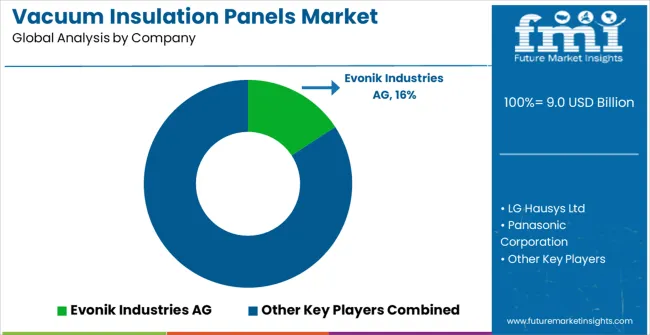
| Item | Value |
|---|---|
| Quantitative Units | USD 9.0 Billion |
| Material Type | Silica Vacuum Insulation Panels, Fiberglass Vacuum Insulation Panels, and Other Vacuum Insulation Panels Materials |
| Design Type | Flat Vacuum Insulation Panels and Special Shaped Vacuum Insulation Panels |
| Raw Material Type | Silica Based Vacuum Insulation Panels, Fiber Glass Based Vacuum Insulation Panels, Metal Based Vacuum Insulation Panels, Plastic Based Vacuum Insulation Panels, and Other Raw Material Based Vacuum Insulation Panels |
| Application | Building Construction, Refrigeration & Cooling Appliances, Transport, and Others |
| Regions Covered | North America, Europe, Asia-Pacific, Latin America, Middle East & Africa |
| Country Covered | United States, Canada, Germany, France, United Kingdom, China, Japan, India, Brazil, South Africa |
| Key Companies Profiled | Evonik Industries AG, LG Hausys Ltd, Panasonic Corporation, DOW, OCI Ltd, Kevothermal, LLC, Porextherm Dämmstoffe GmbH, Thermocor, Va-Q-Tec AG, and Microtherm Sentronic GmbH |
The global vacuum insulation panels market is estimated to be valued at USD 9.0 billion in 2025.
The market size for the vacuum insulation panels market is projected to reach USD 13.7 billion by 2035.
The vacuum insulation panels market is expected to grow at a 4.3% CAGR between 2025 and 2035.
The key product types in vacuum insulation panels market are silica vacuum insulation panels, fiberglass vacuum insulation panels and other vacuum insulation panels materials.
In terms of design type, flat vacuum insulation panels segment to command 58.6% share in the vacuum insulation panels market in 2025.






Our Research Products

The "Full Research Suite" delivers actionable market intel, deep dives on markets or technologies, so clients act faster, cut risk, and unlock growth.

The Leaderboard benchmarks and ranks top vendors, classifying them as Established Leaders, Leading Challengers, or Disruptors & Challengers.

Locates where complements amplify value and substitutes erode it, forecasting net impact by horizon

We deliver granular, decision-grade intel: market sizing, 5-year forecasts, pricing, adoption, usage, revenue, and operational KPIs—plus competitor tracking, regulation, and value chains—across 60 countries broadly.

Spot the shifts before they hit your P&L. We track inflection points, adoption curves, pricing moves, and ecosystem plays to show where demand is heading, why it is changing, and what to do next across high-growth markets and disruptive tech

Real-time reads of user behavior. We track shifting priorities, perceptions of today’s and next-gen services, and provider experience, then pace how fast tech moves from trial to adoption, blending buyer, consumer, and channel inputs with social signals (#WhySwitch, #UX).

Partner with our analyst team to build a custom report designed around your business priorities. From analysing market trends to assessing competitors or crafting bespoke datasets, we tailor insights to your needs.
Supplier Intelligence
Discovery & Profiling
Capacity & Footprint
Performance & Risk
Compliance & Governance
Commercial Readiness
Who Supplies Whom
Scorecards & Shortlists
Playbooks & Docs
Category Intelligence
Definition & Scope
Demand & Use Cases
Cost Drivers
Market Structure
Supply Chain Map
Trade & Policy
Operating Norms
Deliverables
Buyer Intelligence
Account Basics
Spend & Scope
Procurement Model
Vendor Requirements
Terms & Policies
Entry Strategy
Pain Points & Triggers
Outputs
Pricing Analysis
Benchmarks
Trends
Should-Cost
Indexation
Landed Cost
Commercial Terms
Deliverables
Brand Analysis
Positioning & Value Prop
Share & Presence
Customer Evidence
Go-to-Market
Digital & Reputation
Compliance & Trust
KPIs & Gaps
Outputs
Full Research Suite comprises of:
Market outlook & trends analysis
Interviews & case studies
Strategic recommendations
Vendor profiles & capabilities analysis
5-year forecasts
8 regions and 60+ country-level data splits
Market segment data splits
12 months of continuous data updates
DELIVERED AS:
PDF EXCEL ONLINE
Metal Structural Insulation Panels Market Size and Share Forecast Outlook 2025 to 2035
Vacuum Heat Shrink Film Market Size and Share Forecast Outlook 2025 to 2035
Vacuum Products for Emergency Services Market Size and Share Forecast Outlook 2025 to 2035
Vacuum Fiber Feedthrough Flanges Market Size and Share Forecast Outlook 2025 to 2035
Vacuum Tension Rolls Market Size and Share Forecast Outlook 2025 to 2035
Vacuum Self-priming Mobile Pumping Station Market Size and Share Forecast Outlook 2025 to 2035
Vacuum Skin Packaging Market Size and Share Forecast Outlook 2025 to 2035
Vacuum-Refill Units Market Analysis - Size and Share Forecast Outlook 2025 to 2035
Vacuum Leak Detectors Market Size and Share Forecast Outlook 2025 to 2035
Insulation Tester Market Size and Share Forecast Outlook 2025 to 2035
Insulation Films Market Size and Share Forecast Outlook 2025 to 2035
Vacuum Pressure Encapsulated Transformer Market Size and Share Forecast Outlook 2025 to 2035
Vacuum Insulated Medium Voltage Switchgear Market Size and Share Forecast Outlook 2025 to 2035
Insulation Paper Market Size and Share Forecast Outlook 2025 to 2035
Vacuum Rated Motors Market Size and Share Forecast Outlook 2025 to 2035
Vacuum Concentrators Market Size and Share Forecast Outlook 2025 to 2035
Insulation Market Size and Share Forecast Outlook 2025 to 2035
Vacuum Insulated Low Voltage Commercial Switchgear Market Size and Share Forecast Outlook 2025 to 2035
Vacuum Pressure Impregnated (VPI) Transformer Market Size and Share Forecast Outlook 2025 to 2035
Vacuum Insulated Pipe Market Size and Share Forecast Outlook 2025 to 2035

Thank you!
You will receive an email from our Business Development Manager. Please be sure to check your SPAM/JUNK folder too.
Chat With
MaRIA